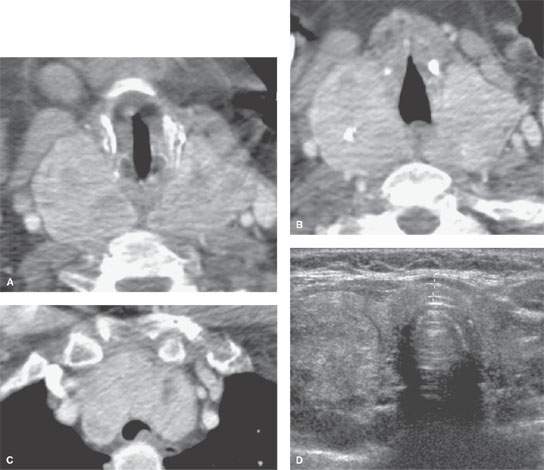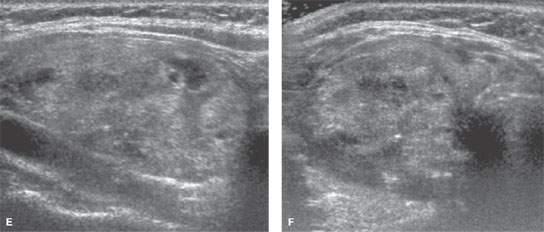GOITER: NONTOXIC THYROID GLAND ENLARGEMENT
KEY POINTS
- Imaging is helpful to confirm a diagnosis of nontoxic thyroid goiter.
- Computed tomography and magnetic resonance imaging are the prime imaging tools to map the extent of a nontoxic goiter and may be done without contrast if this diagnosis has been established with confidence.
- Important associated findings that potentially alter the surgical approach may be revealed by imaging.
- Imaging can suggest an alternative diagnosis or associated diagnosis of thyroid cancer in some patients believed to have simple nontoxic goiter.
- Ultrasound is cost additive, not definitive, and should be avoided in most cases for these reasons.
- Radionuclide imaging studies are only infrequently necessary.
This chapter summarizes how imaging comes into play in patients with goiter. Goiter is described as thyroid enlargement that is not associated with functional derangement or malignancy of the gland. It could be uniformly diffuse or restricted to a particular area. Various conditions are responsible for nontoxic thyroid enlargement. Those conditions are discussed in other chapters in more detail. A thyroid nodule is described as a discrete focal growth of thyroid cells. Thyroid nodules may contribute or just coexist within an enlarged gland.
The prevalence of nontoxic goiter greatly varies based on the geographic location. In regions deficient in iodine, goiters are common and considered endemic. In areas with an iodine-enriched diet, goiters are considered sporadic. The condition is more common in the female and elderly population. Using sonographic evaluation, up to 50% of an unselected population may exhibit an enlarged gland.
Classically, the goiter was thought to be a result of defective thyroid hormone synthesis causing proliferation of the thyroid follicular cells. From sporadic cases and lack of uniform thyroid enlargement within iodine-deficient regions, it appears that various genetic and environmental causes may be responsible for goitrogenesis. Pregnancy exerts a goitrogenic effect due to various hormonal alterations. As a result, multiple pregnancies may be responsible for higher incidence of the disease in the female population. Tobacco smoking, infections, medications, and goitrogens have been implicated as contributing environmental factors. Common family history, the higher concordance rate in monozygotic twins, and sporadic occurrences point out the genetic component of the disease. It has been confirmed with identification of multiple genetic abnormalities. Although serum thyroid-stimulating hormone (TSH) is the major stimulator of thyroid growth, its concentration level is normal in most patients with nontoxic goiter. Even though some follicular cells may be more sensitive to the growth-stimulatory action of TSH, various TSH-independent growth factors—for instance, insulinlike growth factor 1 (IGF-1), epidermal growth factor (EGF), and fibroblast growth factor (FGF)—are responsible for an increase in thyroid gland volume.
The goiter tissue is often heterogeneous, both histologically and physiologically. It contains areas of focal hemorrhage, follicles filled with colloid, zones of hyperplasia, and even neoplasia. These areas tend to be irregular with no distinct transitions. Functionally, the iodine uptake of individual cells within a single follicle varies widely. In addition, some follicles have a high capacity to produce thyroid hormones, whereas others are lacking.
A nontoxic goiter enlargement usually takes many years to develop and become apparent. The great majority of patients with sporadic disease report cosmetic concerns or fear of cancer. In some cases, patients may present with obstructive symptoms such as globus sensation and/or positional shortness of breath. Oddly, despite the dysphagia complaints, it is rare for patients with goiter to display anorexia. Acute bleeding within the gland may lead to acute painful enlargement and exacerbation of the symptoms.
The term goiter, however, is often used more generically in ordering imaging studies, and this chapter outlines steps to be taken to unravel the sometimes unclear use of the term as well as how imaging contributes to decision making in thyroid gland enlargement. Thyroid cancer and discrete nodules and masses are discussed in Chapter 172.
ANATOMY OF SPECIFIC INTEREST
The anatomy of the neck is discussed in general in Chapter 149 and with regard to the thyroid in Chapter 169.
The anatomy of specific interest in this chapter includes the thyroid and its relationships to the cervicothoracic junction and mediastinum, recurrent laryngeal nerve, esophagus, and trachea.
The anatomy of the neck and chest can be greatly distorted by the goiter. There is no predictable pattern of growth; as a result, the entire region must be scrutinized.
IMAGING ISSUES RELATED TO GENERALIZED THYROID GLAND ENLARGEMENT
Extent of a True Nontoxic or Multinodular Goiter
Imaging will be done in these patients to determine the consistency of the gland. After appropriate medical evaluation of thyroid function, radioiodine therapy may be useful to shrink diffusely enlarged glands. For patients who failed to respond or are poor candidates for radioiodine treatment, or prefer immediate relief, surgery is required. In patients with nodular disease, further investigation with fine needle aspiration biopsy should follow. Unfortunately, multiple nodules carry the same risk of malignancy as a single nodule. Indications for surgery may be cosmetic and/or to relieve airway and/or esophageal compression symptoms (Figs. 171.1–171.4). Evidence of vocal cord dysfunction is a red flag suggesting that the enlargement is not benign and likely due to cancer as discussed subsequently. Imaging is essential when otherwise unexplained vocal cord dysfunction is present, as discussed in detail in Chapter 138 on vagal neuropathy and in Chapter 172 on thyroid nodules and cancer.
Non–contrast-enhanced computed tomography (CT) or magnetic resonance imaging (MRI) may be used to map the goiter prior to surgery (Figs. 171.1–171.4). In particular, its extent in the mediastinum has the greatest capacity to alter the surgical approach. Ultrasound and radionuclide studies are generally not useful in these cases.
Inflammatory Disease Mimicking Nontoxic or Multinodular Goiter
Imaging will be done in these conditions, discussed more completely in Chapter 173, under the presumption that medical therapy has failed and surgery is required for reasons just discussed or the cause of the enlargement is unclear. Imaging should be delayed until proper medical evaluation, including thyroid function studies, has been completed. Tenderness supports an inflammatory etiology rather than nontoxic glandular hyperplasia or multinodular goiter (Fig. 171.5). The imaging may be done to identify a possible cause of airway and/or esophageal compression symptoms. Evidence of vocal cord dysfunction is a red flag suggesting that the enlargement is not benign and likely is due to cancer, as discussed subsequently and in Chapters 138 and 172. Imaging is essential when otherwise unexplained vocal cord dysfunction is present.


FIGURE 171.1. Two patients presenting with diffuse enlargement of the thyroid gland without tenderness. A–C: Patient 1. Contrast-enhanced computed tomography showing an extensive multinodular enlargement of the thyroid gland extending from above the level of the hyoid bone in (A) to the mid to lower neck in (B) and into the mediastinum in (C), producing considerable posterior displacement and compression of the trachea as seen in (C). D–F: Patient 2 presenting with diffuse thyroid enhancement without tenderness or evidence of vocal cord dysfunction. Ultrasound showed a multinodular thyroid gland. (continued)
Stay updated, free articles. Join our Telegram channel

Full access? Get Clinical Tree








